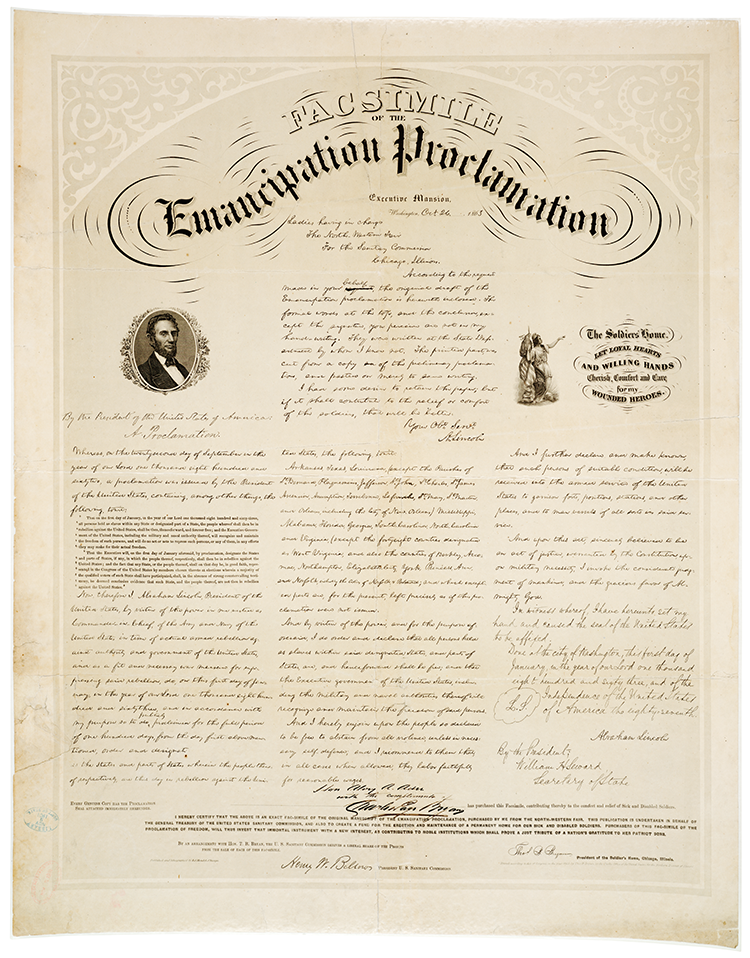
Emancipation Proclamation and DC Emancipation Exhibits Celebrate Freedom
By Kerri Lawrence | National Archives News
WASHINGTON, April 8, 2019 — The National Archives will display two historically significant documents and offer other special related programs this April to celebrate DC Emancipation Day and honor President Abraham Lincoln’s life.
The National Archives will display the Emancipation Proclamation in the museum’s East Rotunda Gallery from April 14 through 16, coinciding with the anniversary of Lincoln’s death on April 15.
Concurrently, the District of Columbia Compensated Emancipation Act of 1862 will be featured in the West Rotunda Gallery from April 12 through 16 in celebration of DC Emancipation Day on April 16.
“As a milestone in the long journey toward abolishing slavery, the Emancipation Proclamation has assumed a place among the great documents of human freedom,” Archivist of the United States David S. Ferriero said. “The story of the Emancipation Proclamation is one that would help to redefine freedom and eventually change the course of history. Both the Proclamation and the DC legislation represent a promise of hope, freedom, and justice that continues to inspire and resonate with the American people more than 150 years after its creation.”
Both documents allowed for the freedom of slaves. President Abraham Lincoln signed the District of Columbia legislation on April 16, 1862, almost nine months before signing the Emancipation Proclamation on January 1, 1863.
The District of Columbia Compensated Emancipation Act of 1862 ended slavery in Washington, DC, freeing 3,100 individuals, reimbursing those who had legally owned them, and offering the newly freed women and men money to emigrate. The District of Columbia celebrates Emancipation Day each April 16 to recognize that freedom for the thousands of DC slaves.
A National Archives “In this Inside the Vaults” video short addresses the petitions filed by owners and slaves under the DC Emancipation Act and the details they reveal about the enslaved African American community at the time. A Prologue magazine story, Slavery and Emancipation in the Nation's Capital, tells the story of two Washington-area families—former slaves and slaveholders—as preserved in Federal records held at the National Archives.
President Lincoln signed the Emancipation Proclamation on January 1, 1863. The document proclaimed that slaves held in areas still in rebellion “are, and henceforward shall be free.” It also announced the acceptance of black men into the Union Army and Navy. By the end of the war, nearly 200,000 black soldiers and sailors had fought for the Union and freedom.
When President Abraham Lincoln signed the Emancipation Proclamation on January 1, 1863, he said, “I never in my life, felt more certain that I was doing right than I do in signing this paper. . . . If my name ever goes into history it will be for this act, and my whole soul is in it.” It has been said that Lincoln viewed this milestone document as his proudest achievement.
A National Archives video shares the significance of the Emancipation Proclamation, its history, and the measures the agency has taken to preserve it.
For conservation reasons, the original Emancipation Proclamation document of January 1, 1863, is displayed only a few days at a time under extremely low light to protect it from damage. The document was last displayed for three days in February 2018 in observance of African American History Month and Abraham Lincoln’s birthday.
The National Archives’ celebration of the Emancipation Proclamation is made possible in part by the National Archives Foundation, through the support of The Boeing Company, which has made a $1.1 million investment to display the proclamation one weekend annually for the next 10 years. The sponsorship will also fund related programs at the Washington, DC, National Archives Museum through 2029.
This year, visitors can view the documents between 10 a.m. and 5:30 p.m. in the National Archives East and West Rotunda Galleries in Washington, DC. Admission is free and open to the public.
Additionally, the Emancipation Proclamation and the DC Compensated Emancipation Act will be on special display together between 6 p.m. and 6:45 p.m. on Tuesday, April 16, 2019, in conjunction with a related public program that evening.
The National Archives will host the program, “DC Emancipation Day and the Emancipation Proclamation,” on Tuesday, April 16, 2019, at 7 p.m. in the William G. McGowan Theater at the Washington, DC, museum. A panel will discuss the history and political implications of both documents. Reservations are recommended but not required. Special performances by the Artists Group Chorale of Washington will take place during the display and at the start of the program.
In addition, hands-on activities centering on the Emancipation Proclamation will be available for visitors at the museum’s Boeing Learning Center on Monday, April 15, 2019, and Tuesday, April 16, 2019, from 11 a.m. to 3 p.m. both days. Guests of all ages can participate free of charge in a variety of writing, mapping, or puzzle activities.
In a related exhibit, the museum;s “Records of Rights” permanent exhibit uses original documents, photographs, videos, and interactive exhibits to explore how Americans have worked to realize the ideals of freedom enshrined in our nation’s founding documents. A special section of this exhibit, “Bending Towards Justice,” showcases the drive for civil rights for African Americans.
For a more detailed history, including transcripts, of the document, see the Emancipation Proclamation page on Archives.gov and "Visitors Get a Rare Opportunity to See the EP" on National Archives News. See the National Archives Catalog to view and download high-resolution images of the Emancipation Proclamation and the District of Columbia Compensated Emancipation Act of 1862. The National Archives’ celebration of the Emancipation Proclamation is made possible in part by the National Archives Foundation through the generous support of The Boeing Company.
